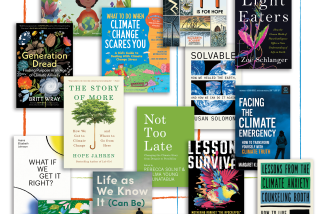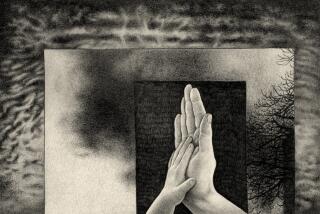Upsetting the delicate balance
Hope for Animals
and Their World
How Endangered Species
Are Being Rescued From the Brink
Jane Goodall
Grand Central: 378 pp., $27.99
--
Dawn Light
Dancing With Cranes
and Other Ways to Start the Day
Diane Ackerman
W.W. Norton: 240 pp., $23.95
--
The frogs are dying. From Canada to Panama, swamps have gone still and rivers silent; insects the amphibians would have devoured proliferate. Creatures with 100 million-year histories have begun disappearing so fast biologists can hardly keep pace. In a decade, half of the 6,000 known species of amphibians may be gone.
And it’s not just frogs. Panda and polar bears, falcons and vultures -- along with certain species of lynx, turtles, fish, deer and rodents -- could disappear within the next decade or two. Hundreds of island birds are already gone; more are artificially maintained in captive breeding programs.
With the climate in carbon-induced chaotic flux, “we are experiencing the Sixth Great Extinction event on Earth,” writes primatologist and conservationist Jane Goodall in “Hope for Animals and Their World: How Endangered Species Are Being Rescued From the Brink.” And yet Goodall, who has watched the Gombe chimpanzees she has tried to save continue to lose habitat and die of disease, refuses to grieve. “Whilst we become despairing or angered as we see how our own prolific and self-centered species continues to destroy,” she writes, “there is yet a feeling of hope.”
That hope is seductive: Environmentalists long to believe we’ve arrived at the moment of reckoning -- the moment, as Barack Obama put it during the 2008 presidential campaign, “when the rise of the oceans began to slow and the planet began to heal.” But Goodall offers little evidence for such optimism. Yes, the peregrine falcon has bounced back, now that large concentrations of DDT in the environment no longer thin the birds’ eggshells. And the American crocodile has made a peculiar recovery near Key Largo, thriving in the 150 miles of canals built to cool effluent from Florida Power & Light’s Turkey Point power station. But these successes are old stories. Goodall doesn’t mention that Turkey Point is not just any power plant but a nuclear power plant, and its role in the reptile’s ironic recovery is a public relations coup for that industry. Nor does she bring up the long-simmering campaign to bring back DDT on the grounds that there’s no better way to defeat malaria. (DDT is still used indoors to control mosquitoes in certain African countries.)
Perhaps the real story would inspire more paralyzing hopelessness than action. And action, or at least funding for conservation projects, is what Goodall is after. So she puts on a brave face and tidies up the accelerating tragedy. In sections subtitled “Never Giving Up” and “The Heroic Struggle to Save Our Island Birds,” her narrative -- written with Gail Hudson and accompanied by field notes from Cincinnati Zoo director Thane Maynard -- tries to offer look-on-the-bright-side updates about some 35 species on the U.S. endangered species list or the International Union for the Conservation of Nature’s “Red List.”
Not one to brood over losses, Goodall instead spends her time honoring the would-be saviors: scientists, filmmakers and lay conservationists who take her on tours and offer souvenirs, such as an antler shed from a tiny Chinese deer that now survives in a cordoned-off preserve or a 26-inch wing feather from a California condor. In return, she tells their stories, playing up triumphs and glossing over controversies. When all hope for restoring a habitat seems to be lost, Goodall puts her faith in zoos.
--
A realist’s approach
Such faith is controversial, but it isn’t surprising: She is a realist, and after a creature has “winked out,” as biologists put it, there’s no getting it back. Captive breeding and zoo protection is especially valuable when a single toxin in the environment has caused a dramatic population decline: Goodall writes heartbreakingly about three species of Asian vulture that have been dying off by the millions, poisoned by a cheap veterinary painkiller called Diclofenac that turns up in the carrion they feed on. Fewer than 1% of the 87 million vultures that once darkened the skies over India now remain. (When Goodall wrote her book it was 3%, which gives you a sense of the speed of the loss.) Carrion-borne illnesses and rabies have spread exponentially as feral dogs take over the vultures’ job. “It just goes to show that we have no idea how human-caused species declines will later impact humans,” Jemima Parry-Jones, director for the International Centre for Birds of Prey, tells Goodall. Indeed, the species we run the risk of endangering may be our own.
And still we don’t stop. “Homo sapiens, the serial killer of the biosphere,” Edward O. Wilson once wrote, “reaches to the far corners of the earth.” In fact, so much has gone wrong -- so much melting, disappearing, burning, eroding; so much destruction that none of us has any power to arrest -- it feels sad even to talk about it. Perhaps that’s why, after the strain of reading Goodall’s effort to squeeze hope out of tragedy, it’s a relief simply to read about nature -- not an argument for nature or a defense of nature, but rather a keenly observed portrait of the world. “How marvelous it is to be alive on a planet that produces trees that grow leafy, bloom and broadcast scent,” Diane Ackerman exults in “Dawn Light: Dancing With Cranes and Other Ways to Start the Day.” “Also that we evolved to appreciate them. After all, we didn’t need to, they don’t bloom for our pleasure.”
--
The connected life
Ackerman, the author of “A Natural History of the Senses” and “The Zookeeper’s Wife,” bases this new book in the first flicker of morning, but “Dawn Light” extends far beyond a time of day into a general celebration of our continually renewed existence. We are not separate from those trees, the author insists; we are always in nature, of nature. She saves squirrels from her swimming pool so often they learn to swim toward her net; she talks to wild starlings, who talk back like parrots. She finds in dogs, construction workers and neighbors characteristics of the world’s wilder creatures. “Shaggy-haired with a soup-strainer mustache, he looks like a sloth,” Ackerman notes of a familiar man walking past, before observing that the two- or three-toed tree creature’s slow pace allows “a complete ecosystem of bugs, bacteria, and other bionts” to live in its fur. “For all I know, the hairy man might be giving asylum to an equal number of freeloaders,” she observes; after all, we all do.
Ackerman writes with clear-eyed consciousness about the current condition of the Earth; she does not flinch from dead baby birds fallen from their nests any more than she turns away from evidence of the changing climate. In a chapter called “Calamity of the Cranes,” she laments the near loss of the whooping crane, the population of which declined from 10,000 to 15 between the arrival of the first Europeans in North America and the 1930s. Here, she and Goodall serendipitously converge, both writing from their separate vantage points about efforts to save North America’s only native crane and the epic service performed by biologists Joe Duff and Bill Lishman, founders of Operation Migration. Dressed in white and carrying crane puppets, the men and their crew climb into ultralight planes to teach captive-born birds how to migrate. They “appear to belong to an arcane religious church,” Ackerman writes, “the Order of Refined Destiny, or perhaps the Celebrants of the Crane.”
To Goodall, who gets a ride in the plane, it’s all good: She is comforted by the “people who have devoted their lives to ensuring that the whooping crane shall not vanish from the marshlands and prairies, rivers and skies, of North America.” Ackerman, by contrast, learns of a flock of 80 patiently nurtured birds struck dead by lightning -- a huge loss to a population that numbers fewer than 400 in the wild -- and channels her grief into a mediation on extinction. “There are some conversations with nature we can no longer have,” she writes. “Without them, how full is our sense of life on Earth?”
That question, of course, remains unanswered, something to ponder as we weigh the costs of salvaging what we have left -- the honeybees, the orb-weaving spiders, the mountains and oceans that 18th century Japanese artist Katsushika Hokusai dramatized in paintings and prints, inspiring Claude Monet to see the Seine in a light that forever altered Western painting. In Ackerman’s view, it’s all knit together, this life on Earth, all connected and glorious. And there’s no better time to reexamine it than at first light.
More to Read
Sign up for Essential California
The most important California stories and recommendations in your inbox every morning.
You may occasionally receive promotional content from the Los Angeles Times.










